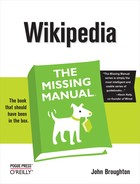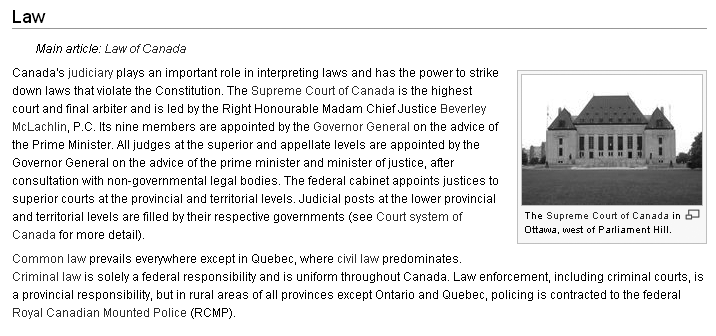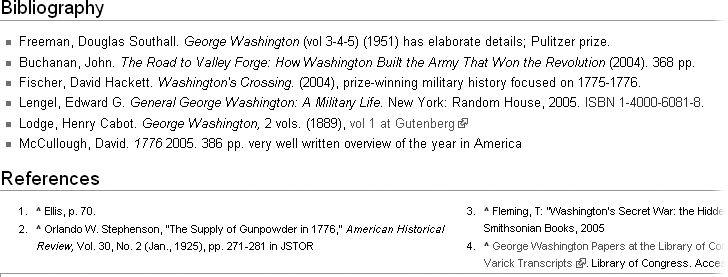Back in high school English, you probably learned how to add footnotes and endnotes to essays and papers. If you didn’t add information about your sources, your paper would get a very low grade.
Wikipedia’s equivalent of a failing grade is to have another editor reverse your edit, putting the article back to exactly as it was before you changed it. If you want to add new information to articles and have it stay there, you need to understand Wikipedia’s rules. This chapter explains those rules. If you follow them, you’ll help ensure the accuracy and credibility of Wikipedia articles.
To add a source (what Wikipedia calls citing a source), you also need to learn some technical matters—how Wikipedia software handles external links, and how it creates footnotes. This chapter includes two tutorials that show you how to create links and footnotes that would make your English teacher proud.
Wikipedia is not the place to document the previously undocumented, to report new discoveries, to publish new theories, or to record personally observed events that may be considered newsworthy. Such content may well be true, but as far as Wikipedia’s policies are concerned, true isn’t enough. Information must be verifiable, which means it must be backed by a published source outside Wikipedia. Simply put, Wikipedia must never be the first place that news appears. If a tree falls in a forest and it’s not reported elsewhere, then Wikipedia isn’t going to report it either.
Note
Some places on the Web welcome original writing and reporting. You’ll find a list at the page Wikipedia:Alternative outlets. Some, such as Wikinews, are sister projects.
Here are Wikipedia’s documentation rules in brief:
What you know is true (or, more accurately, what you think is true) isn’t a criterion for what you can assert on Wikipedia. Information must come from a published, reliable source.
Ideally, always cite your source when you add new information to Wikipedia. If you add a quotation, or if you add something that is likely to be challenged, you absolutely must cite a published, reliable source.
Wikipedia has three core policies for content. Chapter 1 discussed one of them—Neutral point of view (A Few Words about Content). The other two policies are mostly about new content: No original research and Verifiability. You can (and probably should) read those two policies yourself. The shortcuts are WP:NOR and WP:V; on any Wikipedia page, just type one of those into the search box on the left, and then click Go. Misunderstandings of these policies abound. The rest of this section is devoted to clearing up some of the biggest.
Only reliable sources hold up to the scrutiny of the Wikipedia community. But what makes a source reliable? To quote from Wikipedia’s Reliable sources guideline (shortcut: WP:RS): “Articles should be based on reliable, third-party published sources with a reputation for fact-checking and accuracy.” Most international and national newspapers, magazines, and scientific journals put significant resources into avoiding mistakes, to maintain their credibility and readership (and their survival in the face of libel and other lawsuits). On the other hand, an anonymous blogger can feel pretty free to post anything on the Web without worrying about the consequences. The general rule is: “Self-published books, personal Web sites, and blogs are largely not acceptable as sources.” (Wikipedia:Verifiability)
Now that you’ve got the concept of reliability drilled into you, you should know about two situations where otherwise “unreliable” information can appear in Wikipedia articles:
Material from self-published and questionable sources may be used as sources in articles about themselves. You should phrase such information as an assertion. For example, say, “According to Elsbeth Wainwright’s personal Web site, she was born on a mountain,” not simply, “Elsbeth Wainwright was born on a mountain.” The fact that a Web site says something is undisputable, and that’s the fact you’re asserting in this case.
Editorial opinions in newspapers aren’t the same as news articles, and you should treat them differently. For example, you can say, “The Catfish Gazette opposed the destruction of the historical courthouse,” if you read that opinion on the Gazette’s editorial page. But you must not use wording that makes it look like opinions are facts. You can’t, for example, use an editorial opinion to put something like this into a Wikipedia article: “The destruction of local landmarks in Catfish township in the past 20 years has been a tragedy and a travesty.” (Notice also the violation of Neutral point of view.)
In four situations, you can put specific information into an article without citing a source. Mind you, the information must still be verifiable; you simply don’t need to accompany it with a citation in these situations.
In the lead section. The initial section of an article should be a concise overview of the article, establishing context, summarizing the most important points, and explaining why the subject is interesting and notable. Citations aren’t generally appropriate in the lead section; they belong in the body of the article. (Sometimes you do have to provide citations, if other editors insist.) Figure 2-1 is a good example of a lead section. (Lead sections are discussed in more detail on Lead Section).
If a section of an article summarizes what is in another, more detailed article. In Wikipedia, such a section is called summary style, and should be a couple of paragraphs long. Immediately below the heading of the section is a link to the main article, which contains all the sources. Figure 2-2 shows a section of an article that demonstrates summary style.
If there’s an internal link to another article. For example, suppose you add this to an article: “Name of person, a historian who was written extensively about this period, said quotation.” You don’t have to document who this person is, because the reader can follow the internal link to the Wikipedia article about the person. That article, of course, should support your phrase, “a historian who has written extensively about this period.” Note that you do have to add a source to document the quotation.
If the information in an article is documented in a section at the bottom of the article. Consider an article that is based on primarily on books, like George Washington in the American Revolution. In such cases, you can document most of the information by simply listing those books in a “Bibliography” section at the end of the article (Figure 2-3).
Figure 2-3. Here are the sources for the article George Washington in the American Revolution. These two sections appear at the bottom of that article. The “Bibliography” section lists six books. By contrast, there are only four footnotes—only four cases in this article where text is footnoted to show exactly where it came from.
If you add potentially contentious information to an article, you absolutely must add a citation immediately following that information, so others can verify it. If you’re the one who adds information to an article, the burden of proof rests on you. If another editor questions you about a specific phrase, sentence, or paragraph, the correct response is to cite your source, as a footnote, rather than say, “Find it yourself—I’m sure one of the sources in the article supports what I put in.”
Wikipedia considers anything negative about a person or organization to be controversial or contentious. Editors also often challenge causal statements. (“Because the president vetoed the tax cuts, the country went into a recession.”) If you add such a statement, it had better come from a reliable source, not your own opinion. When the topic of an article is controversial, other editors may interpret almost any information you add to that article as controversial. But if you always cite a good source that supports the information you’re adding, then you can defend yourself if you’re accused of adding original research or your personal point of view.
Say you’ve come across an online newspaper article with lots of information you want to add to a Wikipedia article. That’s great, but don’t just copy and paste large amounts of text—that’s a copyright violation. Stick to the facts (facts can’t be copyrighted), and recognize that newspapers don’t object to small percentages of a story’s text ending up in Wikipedia if the newspaper gets credit (via citation), particularly if you provide a link to the full story online. (For a discussion about what you can legally copy in large amounts, see Don’t Repeat Someone Else’s Words at Length.)



